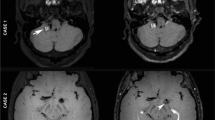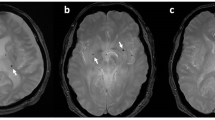Abstract
Purpose
Endovascular treatment of unruptured intracranial aneurysms may increase cerebral microbleeds (CMBs) in postprocedural T2*-weighted MRIs, which may be a risk for future intracerebral hemorrhage. This study examined the characteristics of postprocedural CMBs and the factors that cause their increase.
Methods
The patients who underwent endovascular treatment for unruptured intracranial aneurysms from April 2016 to February 2018 were retrospectively analyzed. Treatment techniques for endovascular treatment included simple coiling, balloon-assisted coiling, stent-assisted coiling, or flow diverter placement. To evaluate the increase in CMBs, a head MRI including diffusion-weighted imaging and T2*-weighted MRIs was performed on the preprocedural day; the first postprocedural day; and at 1, 3, and 6 months after the procedure.
Results
Among the 101 aneurysms that were analyzed, 38 (37.6%) showed the appearance of new CMBs. In the multivariate analysis examining the causes of the CMB increases, chronic kidney disease, a higher number of preprocedural CMBs, and a higher number of diffusion-weighted imaging–positive lesions on the first postprocedural day were independent risk factors. Furthermore, a greater portion of the increased CMBs was found in cortical and subcortical lesions of the treated vascular perfusion area within 1 month after the procedure.
Conclusion
In endovascular treatment for unruptured intracranial aneurysms, CMBs tended to increase in patients with small vessel disease before the procedure, and it was also implicated in hemorrhagic changes after periprocedural microinfarction.

Similar content being viewed by others
Data availability
The datasets during and/or analyzed during the current study available from the corresponding author on reasonable request.
References
Cruz JP, Chow M, O'Kelly C, Marotta B, Spears J, Montanera W, Fiorella D, Marotta T (2012) Delayed ipsilateral parenchymal hemorrhage following flow diversion for the treatment of anterior circulation aneurysms. AJNR Am J Neuroradiol 33:603–608. https://doi.org/10.3174/ajnr.A3065
Kayan Y, Delgado Almandoz JE, Fease JL, Tran K, Milner AM, Scholz JM (2016) Incidence of delayed ipsilateral intraparenchymal hemorrhage after stent-assisted coiling of intracranial aneurysms in a high-volume single center. Neuroradiology 58:261–266. https://doi.org/10.1007/s00234-015-1624-3
Sim SY, Song J, Oh SY, Kim MJ, Lim YC, Park SK, Shin YS, Chung J (2016) Incidence and characteristics of remote intracerebral hemorrhage after endovascular treatment of unruptured intracranial aneurysms. World Neurosurg 95:335–340. https://doi.org/10.1016/j.wneu.2016.08.057
Fan YH, Zhang L, Lam WW, Mok VC, Wong KS (2003) Cerebral microbleeds as a risk factor for subsequent intracerebral hemorrhages among patients with acute ischemic stroke. Stroke 34:2459–2462. https://doi.org/10.1161/01.STR.0000090841.90286.81
Bokura H, Saika R, Yamaguchi T, Nagai A, Oguro H, Kobayashi S, Yamaguchi S (2011) Microbleeds are associated with subsequent hemorrhagic and ischemic stroke in healthy elderly individuals. Stroke 42:1867–1871. https://doi.org/10.1161/STROKEAHA.110.601922
Charidimou A, Kakar P, Fox Z, Werring DJ (2013) Cerebral microbleeds and recurrent stroke risk: systematic review and meta-analysis of prospective ischemic stroke and transient ischemic attack cohorts. Stroke 44:995–1001. https://doi.org/10.1161/STROKEAHA.111.000038
Wilson D, Charidimou A, Ambler G, Fox ZV, Gregoire S, Rayson P, Imaizumi T, Fluri F, Naka H, Horstmann S, Veltkamp R, Rothwell PM, Kwa VIH, Thijs V, Lee YS, Kim YD, Huang Y, Wong KS, Jäger HR, Werring DJ (2016) Recurrent stroke risk and cerebral microbleed burden in ischemic stroke and TIA: a meta-analysis. Neurology 87:1501–1510. https://doi.org/10.1212/WNL.0000000000003183
Ogawa Ito A, Shindo A, Ii Y, Matsuura K, Tabei KI, Maeda M, Umino M, Suzuki Y, Shiba M, Toma N, Suzuki H, Tomimoto H (2019) Microbleeds after carotid artery stenting: small embolism may induce cerebral microbleeds. Cerebrovasc Dis Extra 9:57–65. https://doi.org/10.1159/000500112
Shi ZS, Duckwiler GR, Jahan R, Tateshima S, Gonzalez NR, Szeder V, Saver JL, Kim D, Ali LK, Starkman S, Vespa PM, Salamon N, Villablanca JP, Viñuela F, Feng L, Loh Y, Liebeskind DS (2015) New cerebral microbleeds after mechanical thrombectomy for large-vessel occlusion strokes. Medicine 94:e2180. https://doi.org/10.1097/MD.0000000000002180
Gao Y, Nie K, Duan Z, Wang S, Ma G, Zhang X, Li C, Zhang Y, Dai C, Wang L (2019) A follow-up study of cerebral microbleeds in patients who received stents for symptomatic cerebral artery stenosis. Ann Vasc Surg 58:338–346. https://doi.org/10.1016/j.avsg.2018.11.031
Nishikawa Y, Satow T, Takagi T, Murao K, Miyamoto S, Iihara K (2013) Efficacy and safety of single versus dual antiplatelet therapy for coiling of unruptured aneurysms. J Stroke Cerebrovasc Dis 22:650–655. https://doi.org/10.1016/j.jstrokecerebrovasdis.2012.02.008
Wakhloo AK, Linfante I, Silva CF, Samaniego EA, Dabus G, Etezadi V, Spilberg G, Gounis MJ (2012) Closed-cell stent for coil embolization of intracranial aneurysms: clinical and angiographic results. AJNR Am J Neuroradiol 33:1651–1656. https://doi.org/10.3174/ajnr.A3034
Rossen JD, Chalouhi N, Wassef SN, Thomas J, Abel TJ, Jabbour PM, Kung DK, Hasan DM (2012) Incidence of cerebral ischemic events after discontinuation of clopidogrel in patients with intracranial aneurysms treated with stent-assisted techniques. J Neurosurg 117:929–933. https://doi.org/10.3171/2012.8.JNS12185
Becske T, Potts MB, Shapiro M, Kallmes DF, Brinjikji W, Saatci I, McDougall CG, Szikora I, Lanzino G, Moran CJ, Woo HH, Lopes DK, Berez AL, Cher DJ, Siddiqui AH, Levy EI, Albuquerque FC, Fiorella DJ, Berentei Z, Marosföi M, Cekirge SH, Nelson PK (2017) Pipeline for uncoilable or failed aneurysms: 3-year follow-up results. J Neurosurg 127:81–88. https://doi.org/10.3171/2015.6.JNS15311
Roob G, Fazekas F (2000) Magnetic resonance imaging of cerebral microbleeds. Curr Opin Neurol 13:69–73. https://doi.org/10.1097/00019052-200002000-00013
Becske T, Kallmes DF, Saatci I, McDougall CG, Szikora I, Lanzino G, Moran CJ, Woo HH, Lopes DK, Berez AL, Cher DJ, Siddiqui AH, Levy EI, Albuquerque FC, Fiorella DJ, Berentei Z, Marosfoi M, Cekirge SH, Nelson PK (2013) Pipeline for uncoilable or failed aneurysms: results from a multicenter clinical trial. Radiology 267:858–868. https://doi.org/10.1148/radiol.13120099
Fischer S, Vajda Z, Aguilar Perez M, Schmid E, Hopf N, Bäzner H, Henkes H (2012) Pipeline embolization device (PED) for neurovascular reconstruction: initial experience in the treatment of 101 intracranial aneurysms and dissections. Neuroradiology 54:369–382. https://doi.org/10.1007/s00234-011-0948-x
Brinjikji W, Murad MH, Lanzino G, Cloft HJ, Kallmes DF (2013) Endovascular treatment of intracranial aneurysms with flow diverters: a meta-analysis. Stroke 44:442–447. https://doi.org/10.1161/STROKEAHA.112.678151
Sweid A, Starke RM, Herial N, Chalouhi N, Das S, Baldassari MP, Alexander TD, Tjoumakaris S, Gooch MR, Hasan D, Rosenwasser RH, Romo V, Jabbour P (2019) Predictors of complications, functional outcome, and morbidity in a large cohort treated with flow diversion. Neurosurgery. 87:730–743. https://doi.org/10.1093/neuros/nyz508
Nakae R, Nagaishi M, Kawamura Y, Tanaka Y, Hyodo A, Suzuki K (2019) Microhemorrhagic transformation of ischemic lesions on T2*-weighted magnetic resonance imaging after pipeline embolization device treatment. J Neurosurg 130:1997–2004. https://doi.org/10.3171/2017.12.JNS172480
Fazekas F, Kleinert R, Roob G, Kleinert G, Kapeller P, Schmidt R, Hartung HP (1999) Histopathologic analysis of foci of signal loss on gradient-echo T2*-weighted MR images in patients with spontaneous intracerebral hemorrhage: evidence of microangiopathy-related microbleeds. AJNR Am J Neuroradiol 20:637–642
Fisher M (2014) Cerebral microbleeds: where are we now? Neurology 83:1304–1305. https://doi.org/10.1212/WNL.0000000000000871
Kim SH, Shin DW, Yun JM, Lee JE, Lim JS, Cho BL, Kwon HM, Park JH (2017) Kidney dysfunction and cerebral microbleeds in neurologically healthy adults. PLoS One 12:e0172210. https://doi.org/10.1371/journal.pone.0172210
Cho AH, Lee SB, Han SJ, Shon YM, Yang DW, Kim BS (2009) Impaired kidney function and cerebral microbleeds in patients with acute ischemic stroke. Neurology 73:1645–1648. https://doi.org/10.1212/WNL.0b013e3181c1defa
Laible M, Horstmann S, Möhlenbruch M, Wegele C, Rizos T, Schüler S, Zorn M, Veltkamp R (2015) Renal dysfunction is associated with deep cerebral microbleeds but not white matter hyperintensities in patients with acute intracerebral hemorrhage. J Neurol 262:2312–2322. https://doi.org/10.1007/s00415-015-7840-2
Lee M, Saver JL, Hong KS, Rao NM, Wu YL, Ovbiagele B (2013) Risk-benefit profile of long-term dual- versus single-antiplatelet therapy among patients with ischemic stroke: a systematic review and meta-analysis. Ann Intern Med 159:463–470. https://doi.org/10.7326/0003-4819-159-7-201310010-00006
Nishi H, Nakahara I, Matsumoto S, Hashimoto T, Ohta T, Sadamasa N, Ishibashi R, Gomi M, Saka M, Miyata H, Watanabe S, Okata T, Sonoda K, Kouge J, Ishii A, Nagata I, Kira J (2016) Platelet reactivity and hemorrhage risk in neurointerventional procedures under dual antiplatelet therapy. J Neurointerv Surg 8:949–953. https://doi.org/10.1136/neurintsurg-2015-011844
Delgado Almandoz JE, Crandall BM, Scholz JM, Fease JL, Anderson RE, Kadkhodayan Y, Tubman DE (2014) Last-recorded P2Y12 reaction units value is strongly associated with thromboembolic and hemorrhagic complications occurring up to 6 months after treatment in patients with cerebral aneurysms treated with the pipeline embolization device. AJNR Am J Neuroradiol 35:128–135. https://doi.org/10.3174/ajnr.A3621
Ajadi E, Kabir S, Cook A, Grupke S, Alhajeri A, Fraser JF (2019) Predictive value of platelet reactivity unit (PRU) value for thrombotic and hemorrhagic events during flow diversion procedures: a meta-analysis. J Neurointerv Surg 11:1123–1128. https://doi.org/10.1136/neurintsurg-2019-014765
Jeon SB, Kang DW (2007) Neurological Picture. Cerebral air emboli on T2-weighted gradient-echo magnetic resonance imaging. J Neurol Neurosurg Psychiatry 78:871. https://doi.org/10.1136/jnnp.2006.102954
Funding
None.
Author information
Authors and Affiliations
Corresponding author
Ethics declarations
Conflict of interest
We declare that we have no conflict of interest.
Ethical approval
All procedures performed in studies involving human participants were in accordance with the ethical standards of the institutional and/or national research committee and with the 1964 Helsinki declaration and its later amendments or comparable ethical standards.
Informed consent
Informed consent was obtained from all individual participants included in the study.
Additional information
Publisher’s note
Springer Nature remains neutral with regard to jurisdictional claims in published maps and institutional affiliations.
Rights and permissions
About this article
Cite this article
Higashi, E., Hatano, T., Ando, M. et al. Factors associated with the new appearance of cerebral microbleeds after endovascular treatment for unruptured intracranial aneurysms. Neuroradiology 63, 1079–1085 (2021). https://doi.org/10.1007/s00234-020-02616-4
Received:
Accepted:
Published:
Issue Date:
DOI: https://doi.org/10.1007/s00234-020-02616-4




